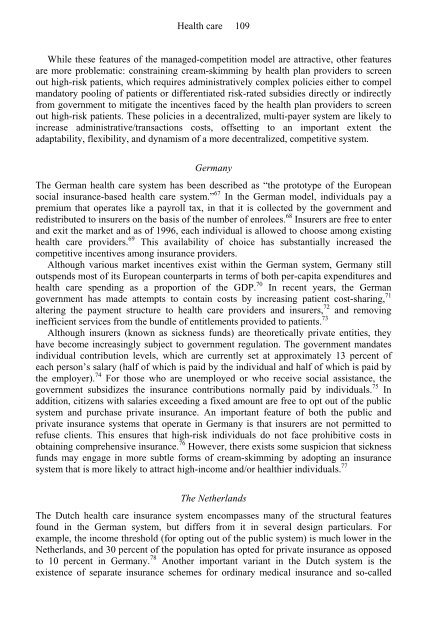Rethinking the Welfare State: The prospects for ... - e-Library
Rethinking the Welfare State: The prospects for ... - e-Library
Rethinking the Welfare State: The prospects for ... - e-Library
You also want an ePaper? Increase the reach of your titles
YUMPU automatically turns print PDFs into web optimized ePapers that Google loves.
Health care 109<br />
While <strong>the</strong>se features of <strong>the</strong> managed-competition model are attractive, o<strong>the</strong>r features<br />
are more problematic: constraining cream-skimming by health plan providers to screen<br />
out high-risk patients, which requires administratively complex policies ei<strong>the</strong>r to compel<br />
mandatory pooling of patients or differentiated risk-rated subsidies directly or indirectly<br />
from government to mitigate <strong>the</strong> incentives faced by <strong>the</strong> health plan providers to screen<br />
out high-risk patients. <strong>The</strong>se policies in a decentralized, multi-payer system are likely to<br />
increase administrative/transactions costs, offsetting to an important extent <strong>the</strong><br />
adaptability, flexibility, and dynamism of a more decentralized, competitive system.<br />
Germany<br />
<strong>The</strong> German health care system has been described as “<strong>the</strong> prototype of <strong>the</strong> European<br />
social insurance-based health care system.” 67 In <strong>the</strong> German model, individuals pay a<br />
premium that operates like a payroll tax, in that it is collected by <strong>the</strong> government and<br />
redistributed to insurers on <strong>the</strong> basis of <strong>the</strong> number of enrolees. 68 Insurers are free to enter<br />
and exit <strong>the</strong> market and as of 1996, each individual is allowed to choose among existing<br />
health care providers. 69 This availability of choice has substantially increased <strong>the</strong><br />
competitive incentives among insurance providers.<br />
Although various market incentives exist within <strong>the</strong> German system, Germany still<br />
outspends most of its European counterparts in terms of both per-capita expenditures and<br />
health care spending as a proportion of <strong>the</strong> GDP. 70 In recent years, <strong>the</strong> German<br />
government has made attempts to contain costs by increasing patient cost-sharing, 71<br />
altering <strong>the</strong> payment structure to health care providers and insurers, 72 and removing<br />
inefficient services from <strong>the</strong> bundle of entitlements provided to patients. 73<br />
Although insurers (known as sickness funds) are <strong>the</strong>oretically private entities, <strong>the</strong>y<br />
have become increasingly subject to government regulation. <strong>The</strong> government mandates<br />
individual contribution levels, which are currently set at approximately 13 percent of<br />
each person’s salary (half of which is paid by <strong>the</strong> individual and half of which is paid by<br />
<strong>the</strong> employer). 74 For those who are unemployed or who receive social assistance, <strong>the</strong><br />
government subsidizes <strong>the</strong> insurance contributions normally paid by individuals. 75 In<br />
addition, citizens with salaries exceeding a fixed amount are free to opt out of <strong>the</strong> public<br />
system and purchase private insurance. An important feature of both <strong>the</strong> public and<br />
private insurance systems that operate in Germany is that insurers are not permitted to<br />
refuse clients. This ensures that high-risk individuals do not face prohibitive costs in<br />
obtaining comprehensive insurance. 76 However, <strong>the</strong>re exists some suspicion that sickness<br />
funds may engage in more subtle <strong>for</strong>ms of cream-skimming by adopting an insurance<br />
system that is more likely to attract high-income and/or healthier individuals. 77<br />
<strong>The</strong> Ne<strong>the</strong>rlands<br />
<strong>The</strong> Dutch health care insurance system encompasses many of <strong>the</strong> structural features<br />
found in <strong>the</strong> German system, but differs from it in several design particulars. For<br />
example, <strong>the</strong> income threshold (<strong>for</strong> opting out of <strong>the</strong> public system) is much lower in <strong>the</strong><br />
Ne<strong>the</strong>rlands, and 30 percent of <strong>the</strong> population has opted <strong>for</strong> private insurance as opposed<br />
to 10 percent in Germany. 78 Ano<strong>the</strong>r important variant in <strong>the</strong> Dutch system is <strong>the</strong><br />
existence of separate insurance schemes <strong>for</strong> ordinary medical insurance and so-called


